Wednesday 21 February 2024 – Roger
It’s around 2100 when we head to Auckland International Airport. The way through security is really slow with only one lane open. We then went to the currency exchange – warning: do not buy currency here unless you order in advance – we got 10% less in USD than we would have got for the same amount had we ordered a week ahead.
We are booked with Air NZ to Singapore but on a Singapore airlines flight. We get to the Air NZ lounge to see a sign at the coffee counter saying for the sake of the environment they no longer use paper cups. Then we head over to the food counter to find paper plates and wooden cutlery. Someone in the hierarchy there must be a little confused.
Thursday 22 February 2024 – Roger
At 0120 we departed for Singapore supported by the excellent service from the airline crew.
Today is a special day for my long-time friend Gary, who is having his farewell from the NZ Army after 54 years service, many of them as an officer in the NZSAS. We joined the army together on the 6 January 1970. Thank you Major Gary S for you dedication to NZ and our army.
Arriving in Singapore we headed to the Marhaba lounge to await the Drukair (Royal Bhutan Airlines) transit check-in to open.
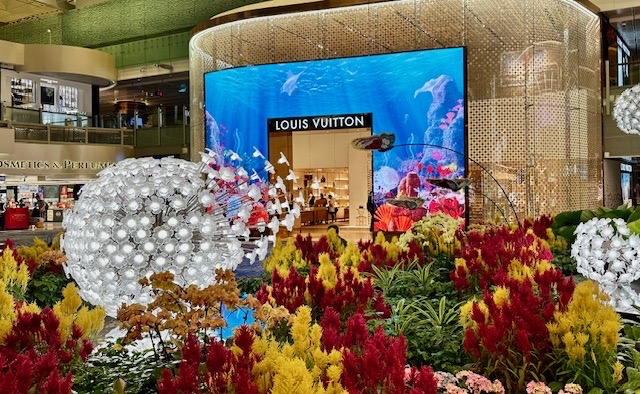
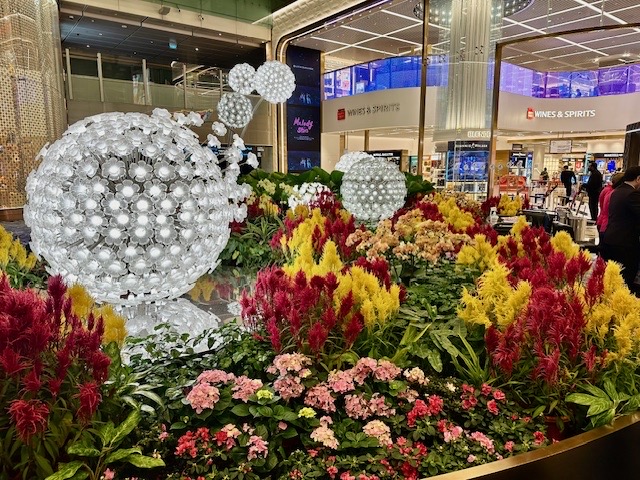 The Butterfly Garden at Changi Airport
The Butterfly Garden at Changi Airport
It was around noon when we bussed out to the Drukair airbus 319. There we sat for close to an hour before clearance to take off was received. Four and a half hours later we touched down at Guwahati in India, where a few people got off and two boarded. We then took off again for the !30 minute flight to Paro in Bhutan.

 View over Guwaharti
View over Guwaharti
It was the last 15 minutes flying that got really interesting, The pilot did warn us it was going to be a bit bumpy “just normal”, that it was normal to fly close to the terrain, and we may not be able to land if the wind was too strong. This turned out to be a really interesting bit of flying as we flew down a narrow valley with large houses perched on the sides of gullies on each side of the plane. The land around them is all terraced with thousands of years of growing rice in the summer and turnips broccolini and such in the winter. The large houses often house several generations of one family/ It was definitely one of the most spectacular approaches I have done to a landing.







The architecture at the airport is very traditional and the immigration staff very friendly. We changed $300 USD receiving 28000 locals. After purchasing a local SIM card we headed outside to be met by our guide, Chimi, and driver, Singye, from Six Senses. They will be with us for our stay in Bhutan.
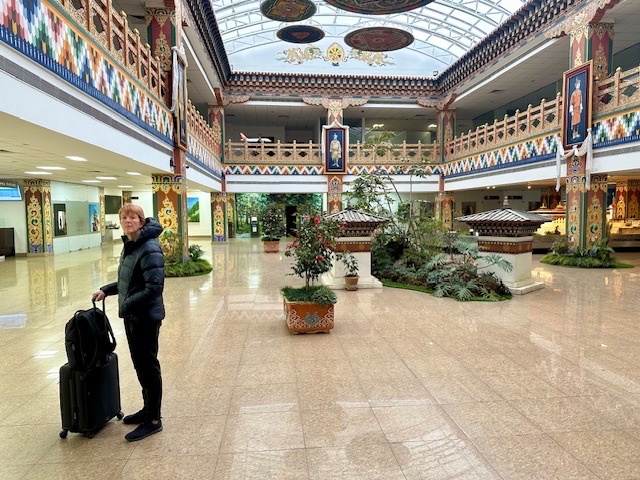
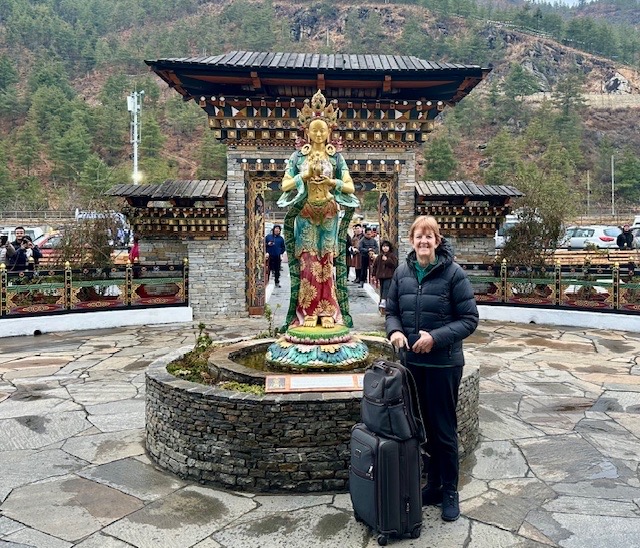
The drive to the Six Senses Thimphu (2,738m) was just over an hour with the road following the Paro Chhu River to Thimphu, where we turned off to head up the hill to the resort. As we arrived and were welcomed we were invited to watch some traditional dances, a weekly event here, before being shown our palatial rooms and heading off for a 90 minute massage.
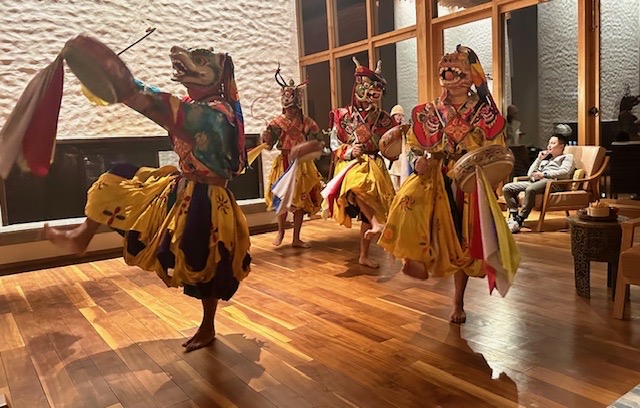

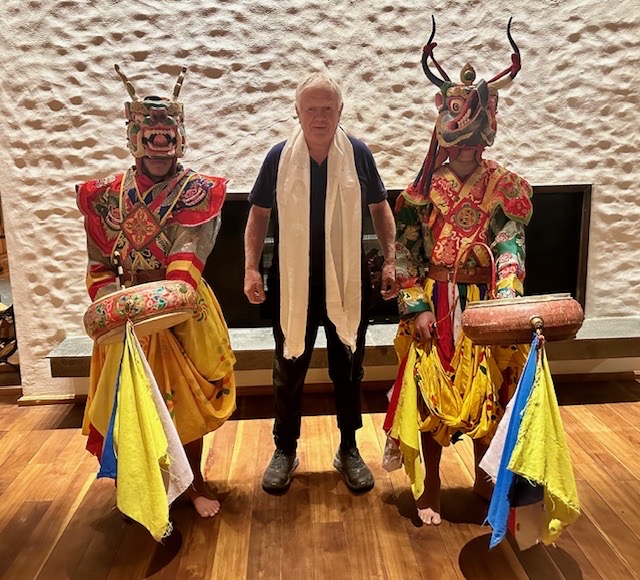
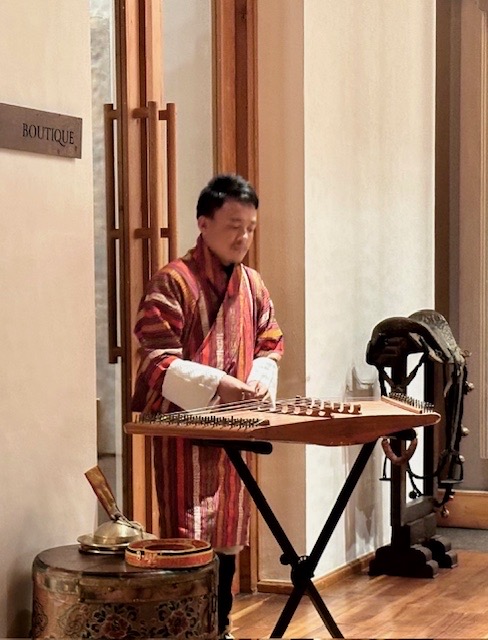
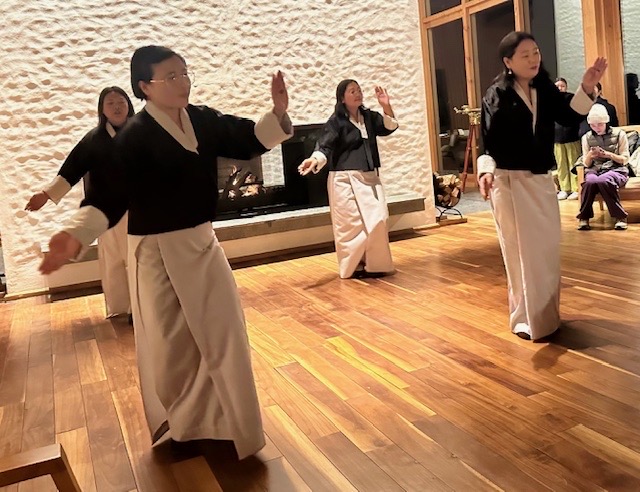

Friday 23 February: Thimphu – Sylvia
We woke this morning to a stunning view from our enormous villa. I can see why Six Senses has named this place the Palace in the Sky. It had been dark when we arrived yesterday and I hadn’t realised how high the mountains around here are. After enjoying a delicious breakfast in the dining room, overlooking Thimphu and the 52m high Buddha Dordenma, we headed off at 9am with Chimi and Singye to start our tour of Thimphu, which is the capital city of Bhutan and the largest with a population of ±115,000.





Our first stop was across the way at the giant Buddha. This temple was initially commissioned in 2005 and opened to the public in 2015. Outside it is impressive – inside, it is by far the most incredible temple I have been in. The detail and workmanship is outstanding. There are hundreds of small Buddha’s lining the walls and the pillars are all beautifully engraved. Unfortunately photos are only allowed outside so you will have to use your imagination for the inside.




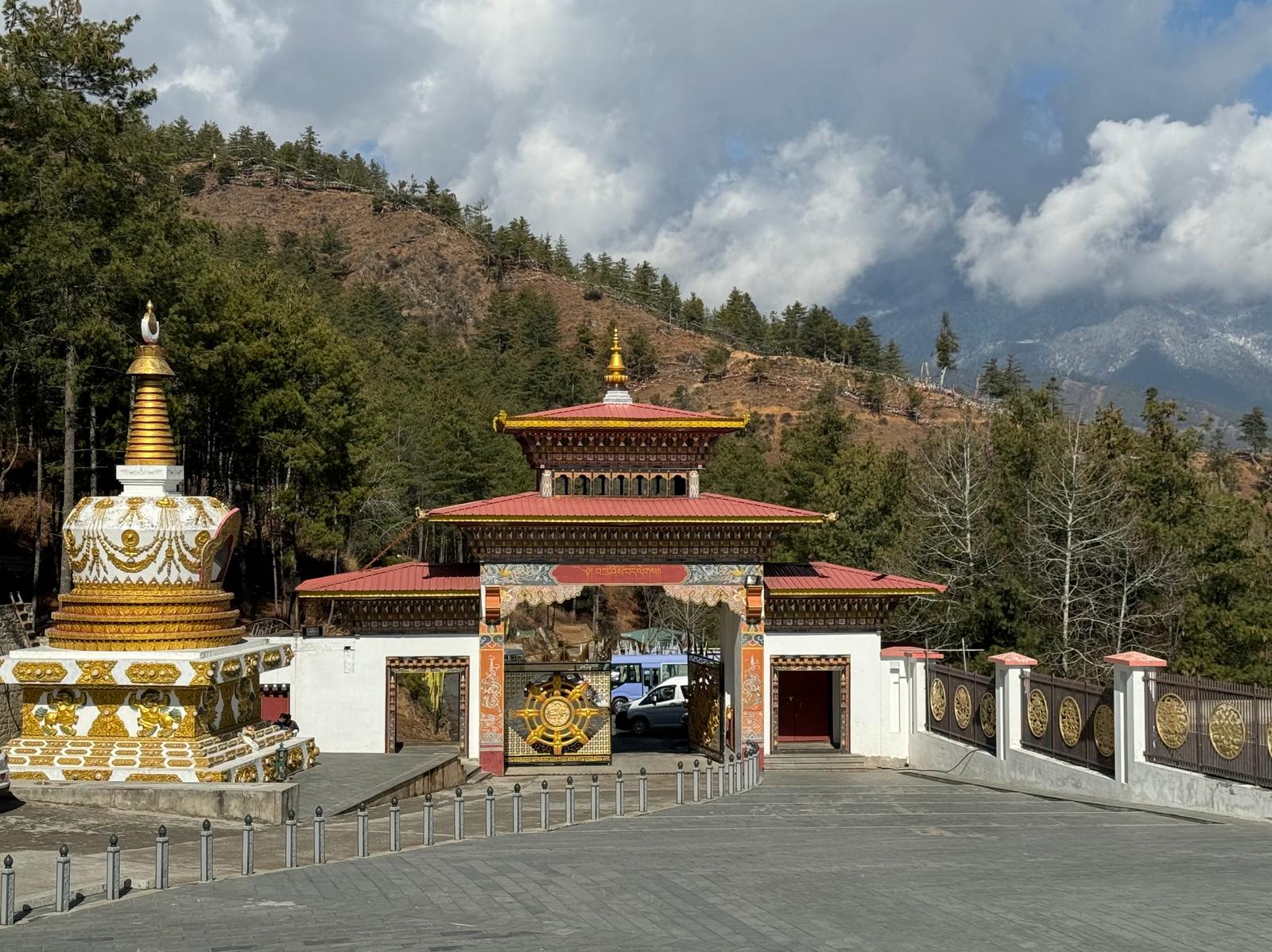

On the way down the hill we stopped to take photos of the Thimphu city. Apparently the buildings with red roofs are governmental and those with green roofs are privately owned. Prayer flags are everywhere, with the five colours representing different elements: red – fire; green – water; blue – space; white – air; yellow – earth. There are also many clusters of large memorial flags scattered on the hillsides.



We next headed to the Memorial Stupa, or Thimphu Chorten, which was built in 1974 in honour of the third king of Bhutan. Building a chorten, or even circumnambulating one is said to accumulate good will. Chortens are receptacles for offerings and generally contain some sort of religious relic. People come from dawn to dusk to circumnambulate the chorten and today, being the King’s birthday holiday, there were crowds of people doing this. We joined in, stopping to spin the prayer wheels first, then walking clockwise around the chorten with the many others who had made the trip here, almost all in traditional Bhutanese dress. Apparently while they may wear western clothing for casual affairs, when visiting a religious or government site, working in an office etc, traditional dress must be worn. This is one of the many ‘rules’ in place that maintain a sense of the traditional Bhutanese culture, one of the key facets of the Gross National Happiness measure.



Many older women sat outside a smaller building alongside the chorten where one lights butter lamps as an offering of wisdom and light of knowledge to eradicate darkness.

Our next stop was the Royal Takin Reserve, a large area set aside for the preservation of takin, the national animal of Bhutan. It has now been expanded to include other injured animals. We were very impressed with the amount of space and also with the many raised walkways that had been built.

Takin

Takin

Yak

Yak

Himalayan Serow
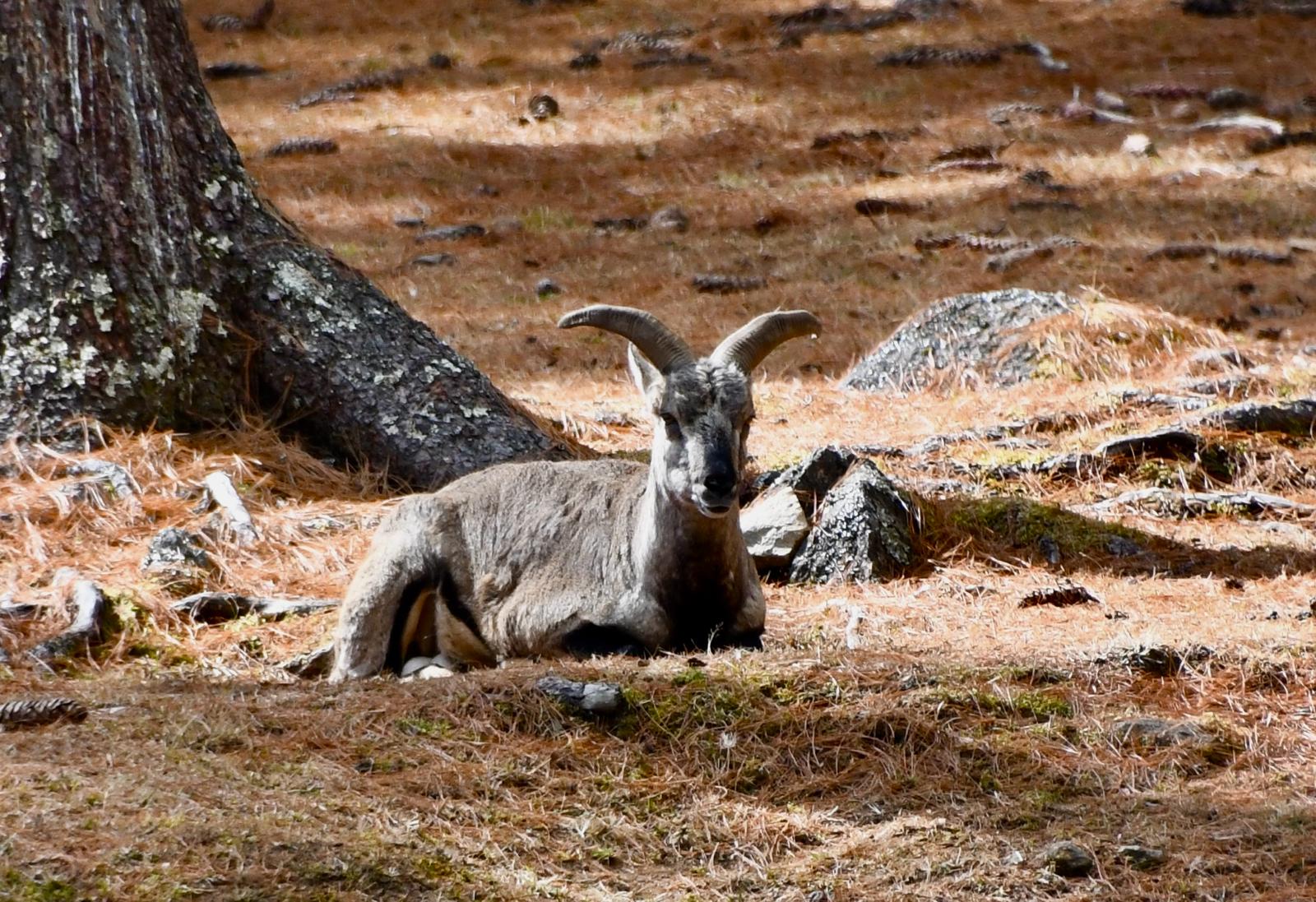
Blue Sheep

After enjoying a delicious lunch at a Six Senses cafe in town, we visited the Tashichho Dzhong, which was first built in 1216 as a place of residence for monks and then expanded in 1745 to house government ministers and officials. It is now an important religious and administrative center and is an impressive piece of architecture. The Bhutanese flag flies proudly outside.


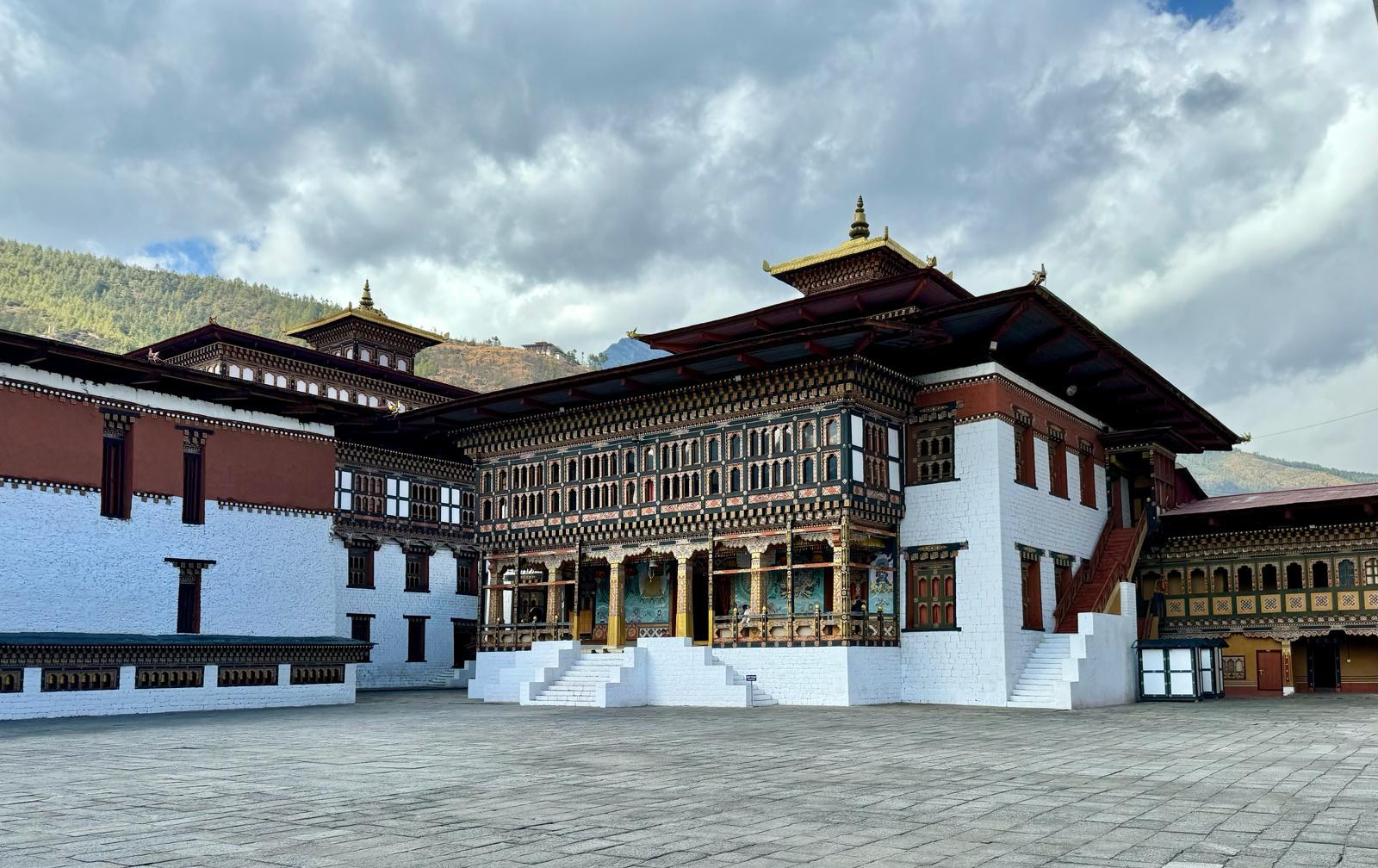
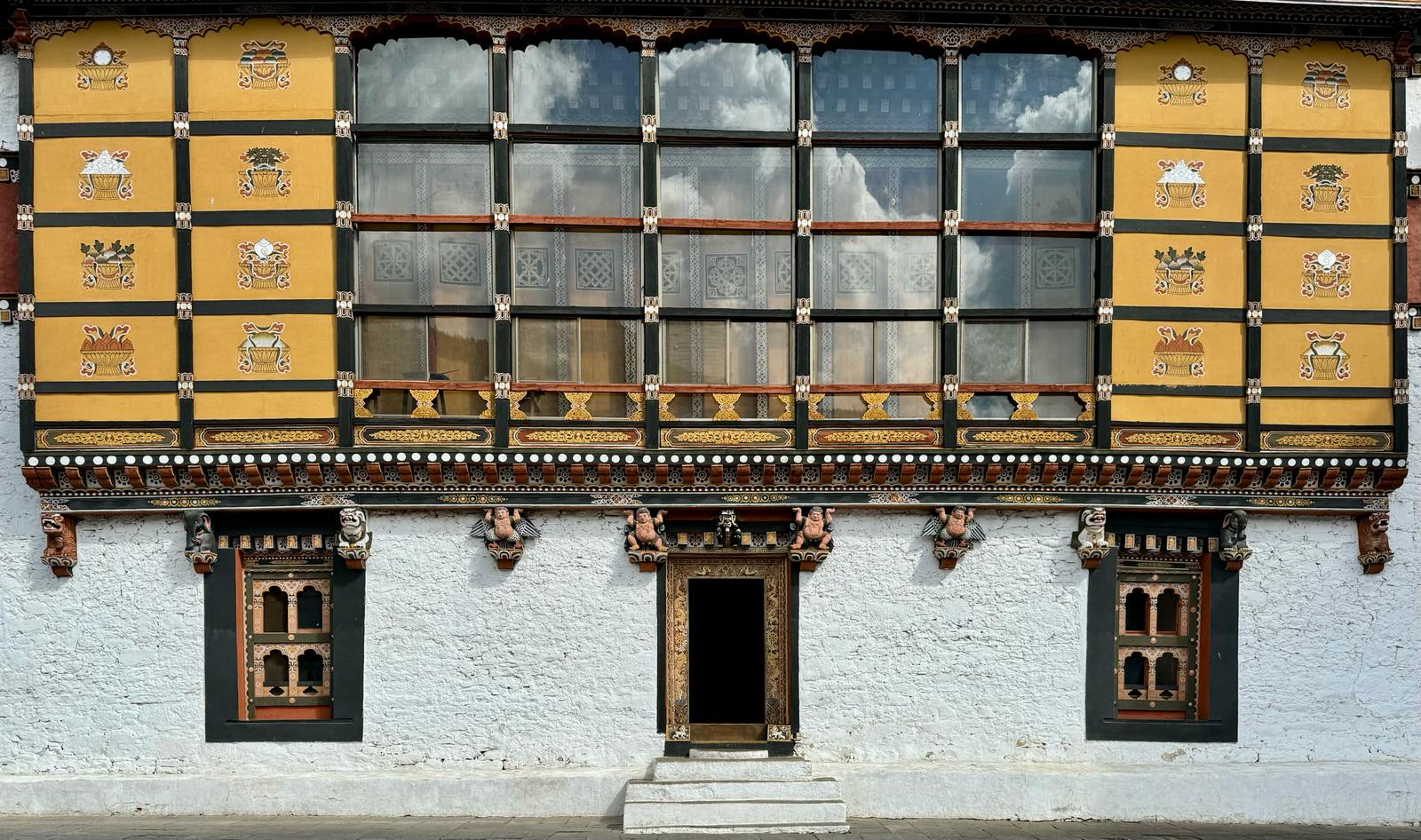
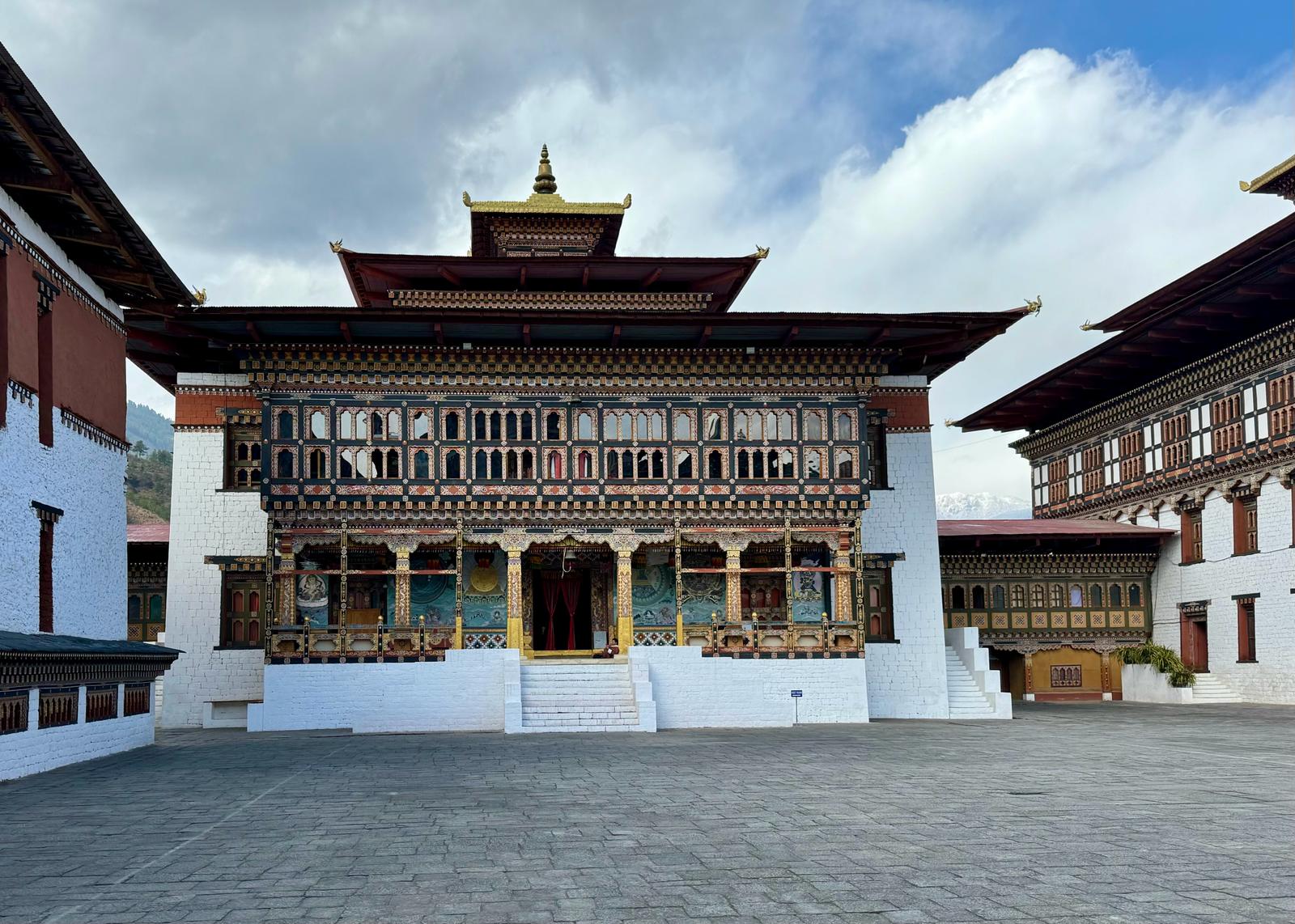


We called in to a specialty art centre, where we got to see a lot of the traditional Bhutanese art. Some of the artists were making wax statues for offerings.
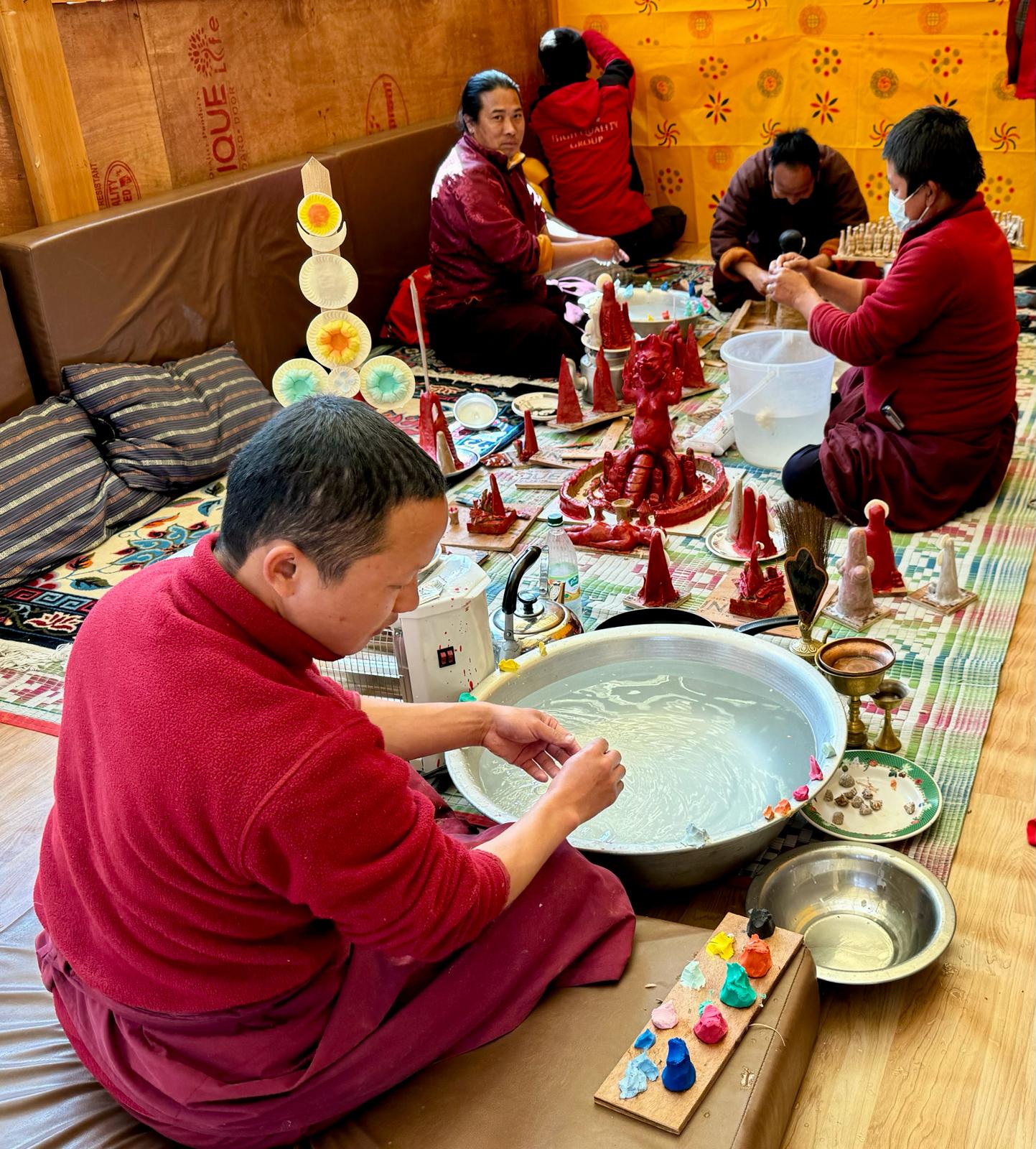


Our last stop was the centre of town where we wandered down the Main Street and tired to take photos of the decorative architecture. Being a public holiday there was a bit of a festival atmosphere. In the main square we were amused to see a merry go round playing “The wheels on the bus go round and round” and a tent where people were playing bingo. There is a huge amount of work that goes into the painting and embellishment of the buildings. It is hard to really capture in the photos. There is also a lot of development in the town, with many building sites and lots of bamboo scaffolding. There are no traffic lights in Bhutan and at the major intersection the traffic police direct the traffic with exaggerated hand gestures.





We returned to the resort, stopping briefly to admire one of the more traditional bridges along the way. It was nice to take a bit of time to relax in our stunning room. We had booked a traditional Dotsho (hot stone) bath at 6pm. I think I now have an even better understanding of the frog in boiling water analogy. This was definitely an experience… we were each in our own rooms and got into a large wooden bath, with khempa, a medicinal herb added, to help ease muscle aches and pains. Five river stones that had been heated for over three hours in fire were rolled down a chute and added to the bath, sizzling and steaming as they hit the water… it heated up significantly. Fifteen minutes later they offered to add more stones – no thank you for me, six more for Roger. Another ten minutes later and I braved two more stones, Roger another three. Bottles of water had been provided and a bowl with three face towels in some ice water. It was all I could do to stop myself tipping the ice water directly in the bath – I had the iced towels on my head and around my neck and still I was over-heating. Roger apparently enjoyed it immensely… no ice towels required. I have to admit, that I do feel very relaxed but this only reiterated for me the limited range of temperatures at which I feel comfortable.

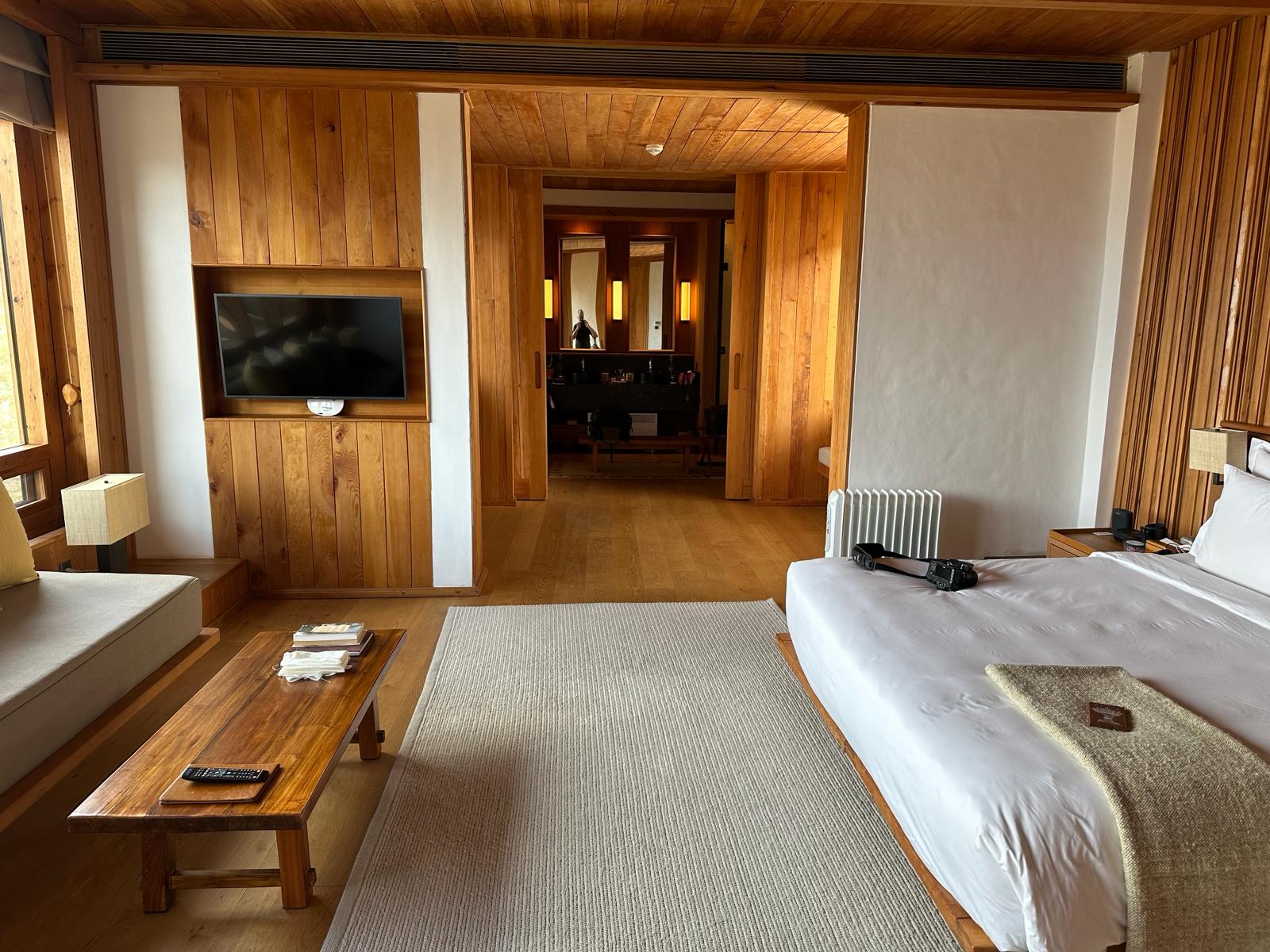
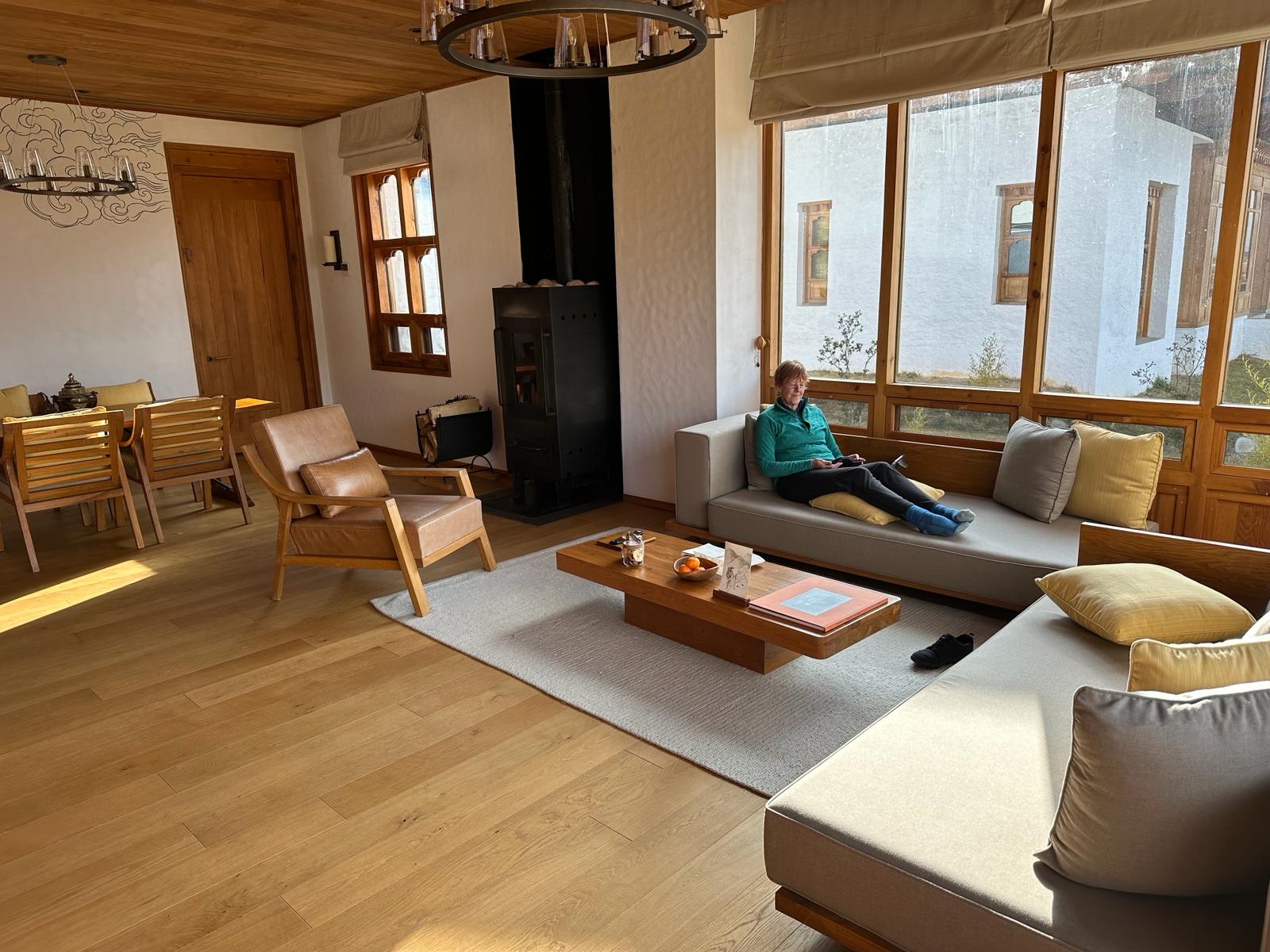


Saturday 24 February – Roger: Thimphu to Paro
It was about 6:30am when we wandered down to the gym, which has a great view of the golden Buddha, sitting high above the city of Thimphu. After completing our respective programs we wandered back to our villa for a shower.


We packed up then headed to breakfast before meeting Chimi and Singye, who took us for a stroll up the hill behind the resort. The track took us up through a pine forest to a prayer memorial with prayer flags on vertical poles. These are placed there after somebodies death – 108 is believed to be an auspicious number although one is just ass effective. The white symbolises air and wind. The base of the pole is dug into the ground to symbolise the connection with the earth and the dagger-like thing on top points upwards to represent the connection with the sky. These particular flags were in quite a state of disrepair; apparently after a year they are supposed to be taken down and burnt but a lot of people don’t get around to doing this. We had a great view from the memorial over the Six Senses resort.
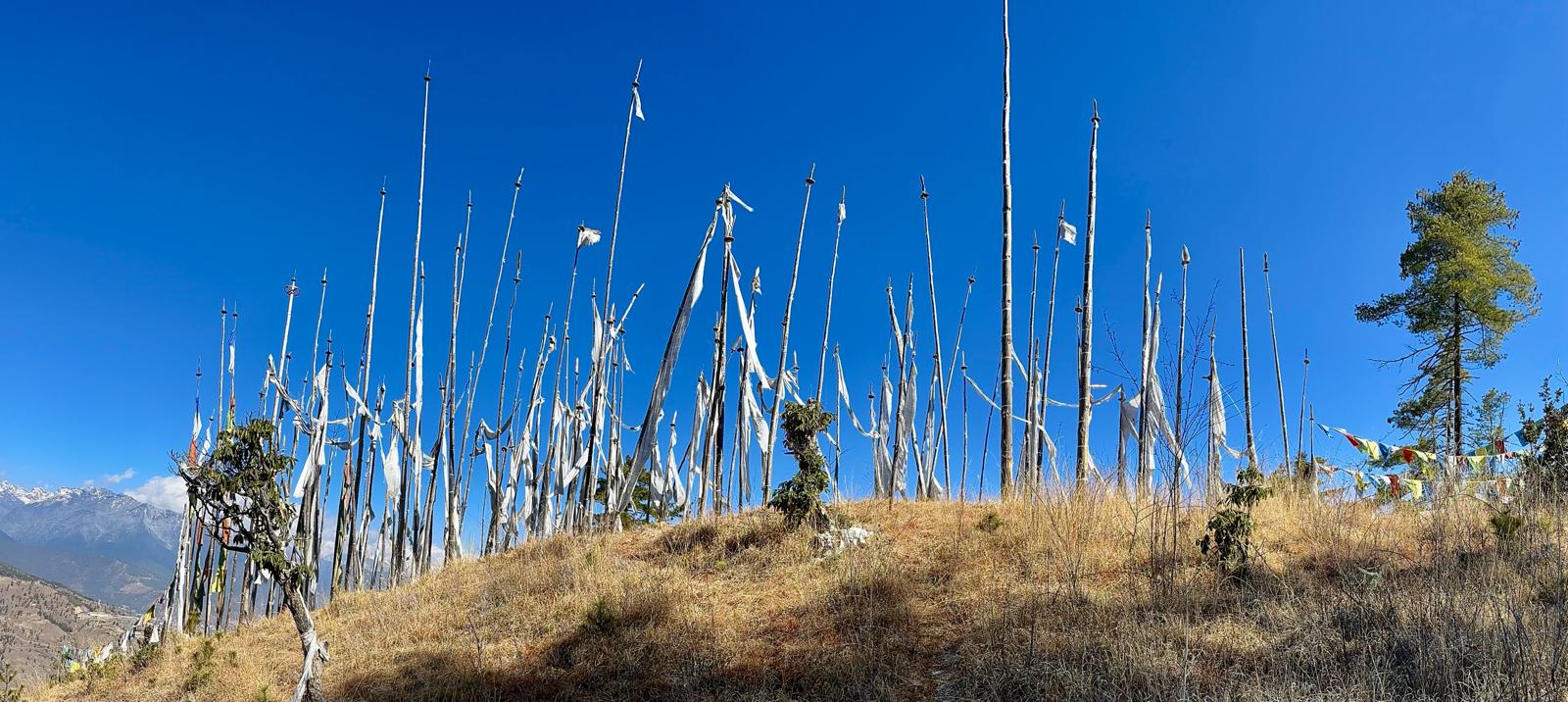
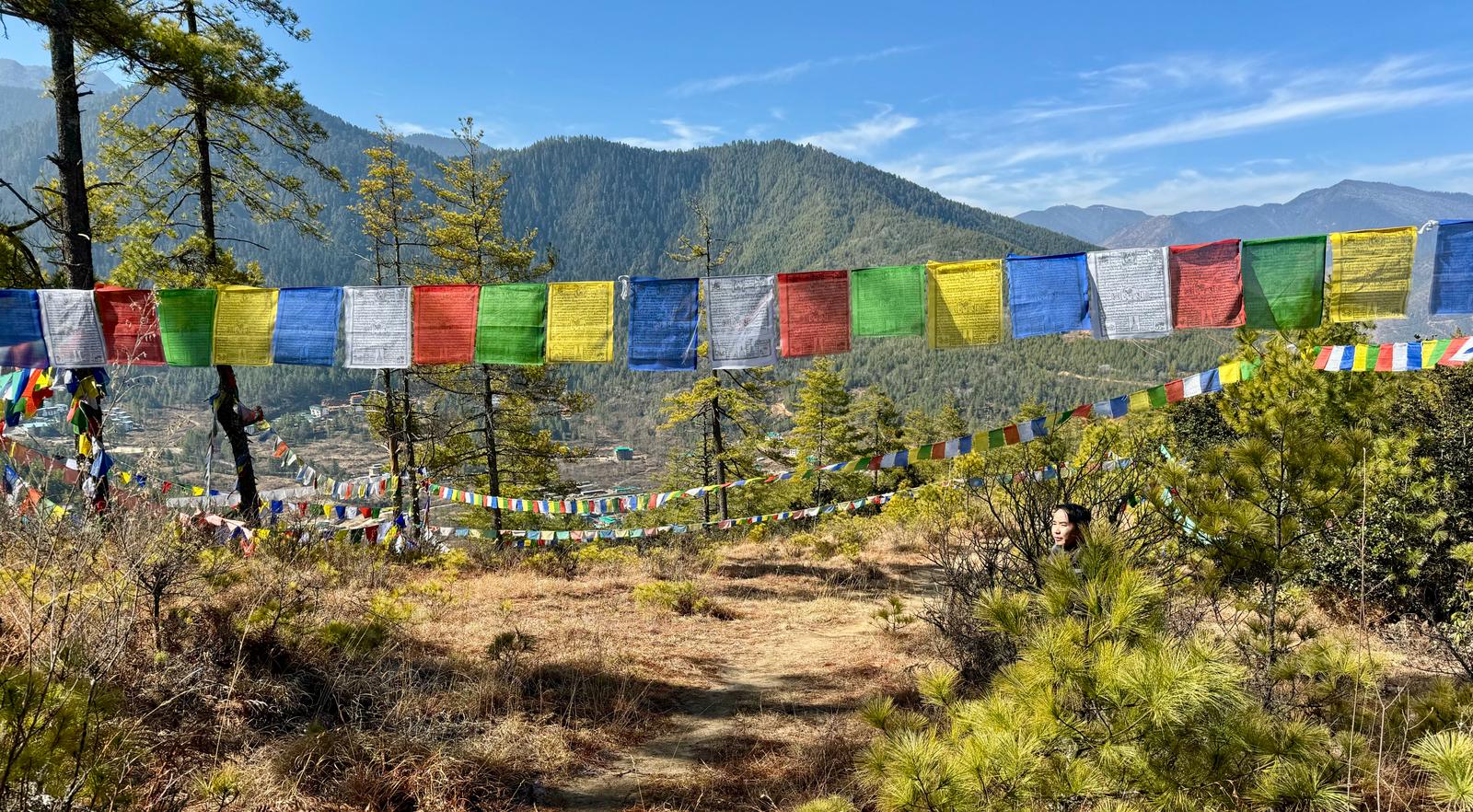


From there we wandered down the hill, overlooking the vast developments in the valleys below, as Thimphu rapidly expands. We passed lots more prayer flags on the way down. As we arrived back at the resort we stopped in to look at the magnificent indoor, heated infinity pool with its view out to the Buddha.

Soon we were on the road to Paro, passing lots of new construction sites as we headed down the hill, turning at a roundabout at the bottom of the hill with a statue of an elephant, a rabbit and a monkey in the middle, apparently representing harmony in the Buddhist religion.
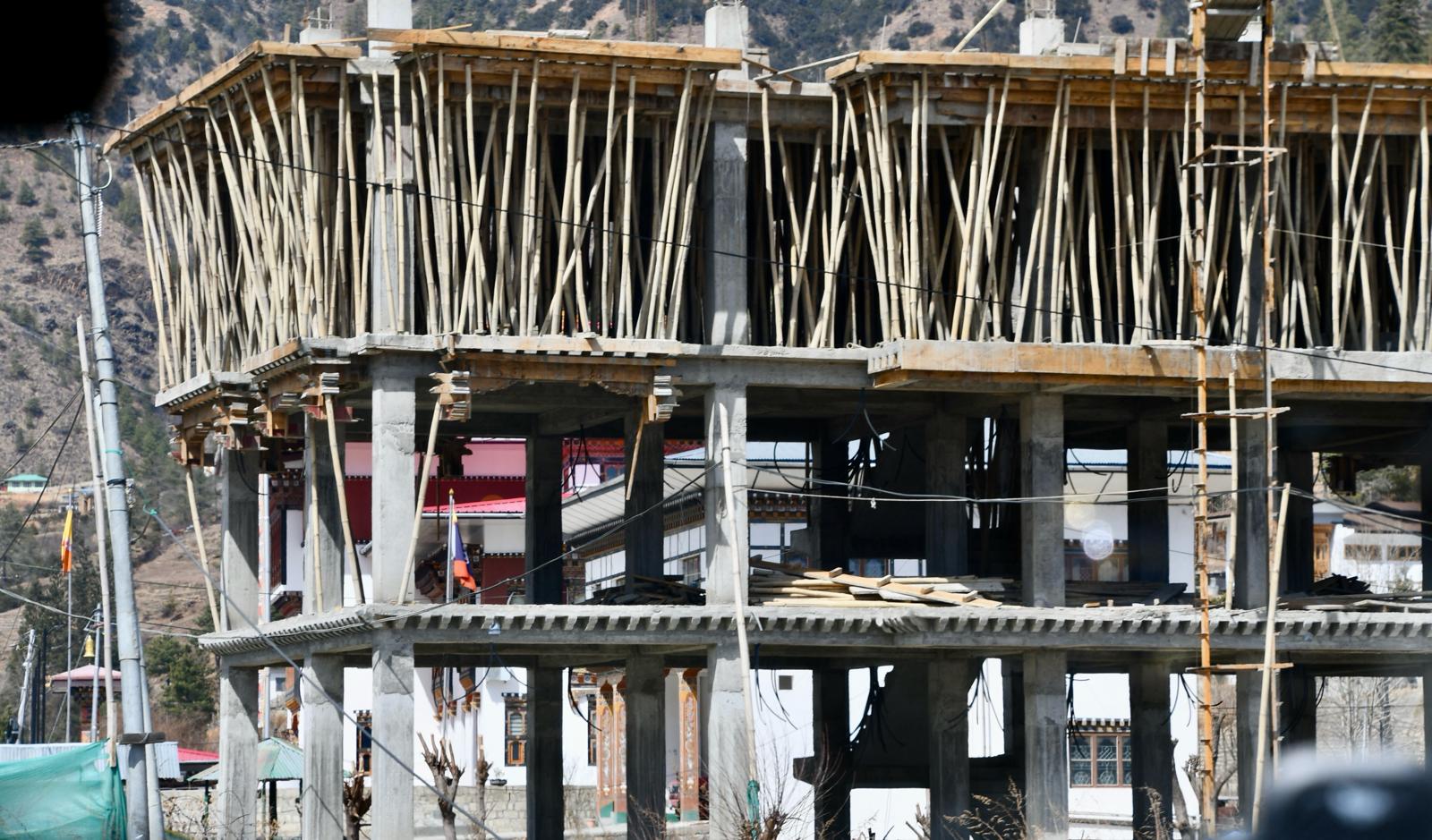
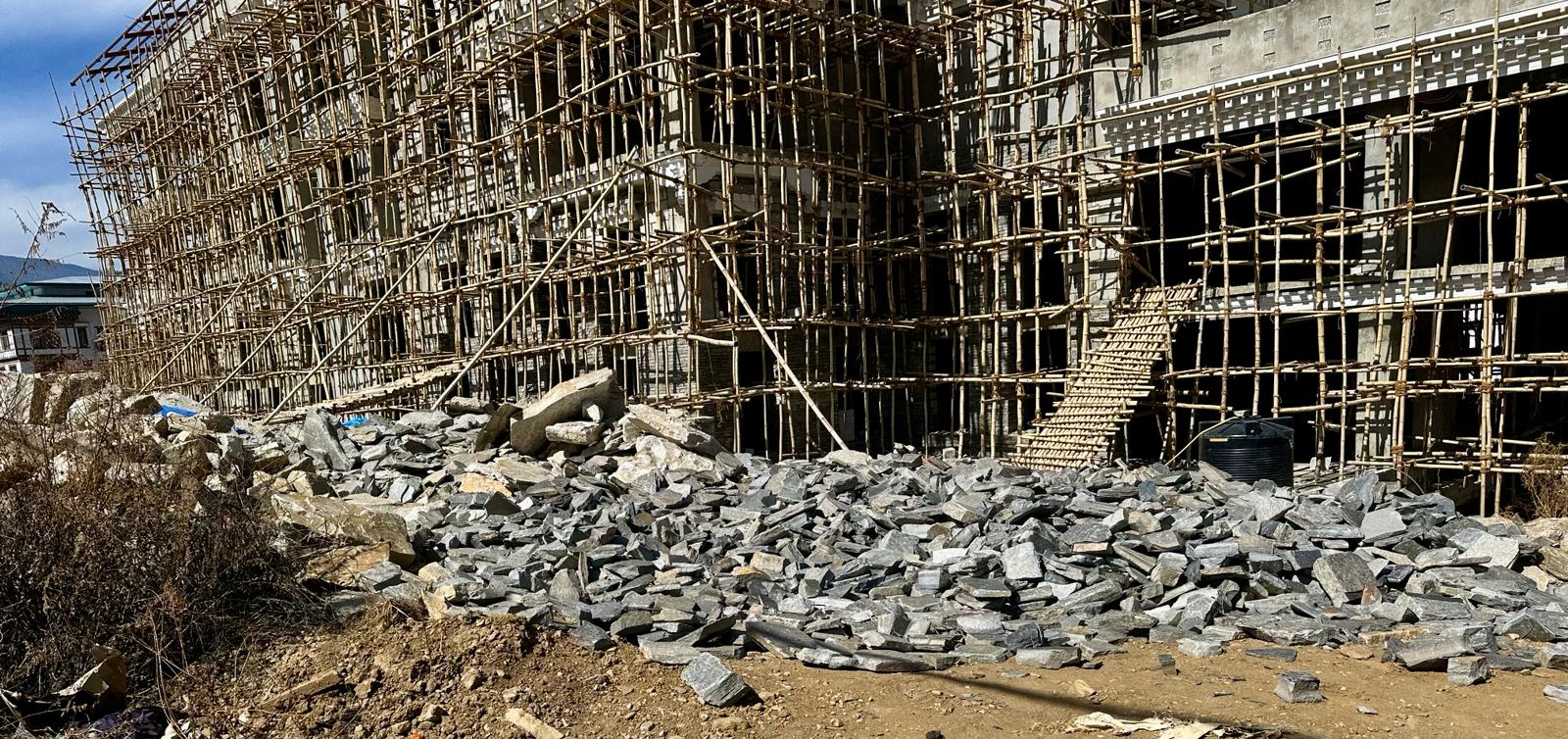
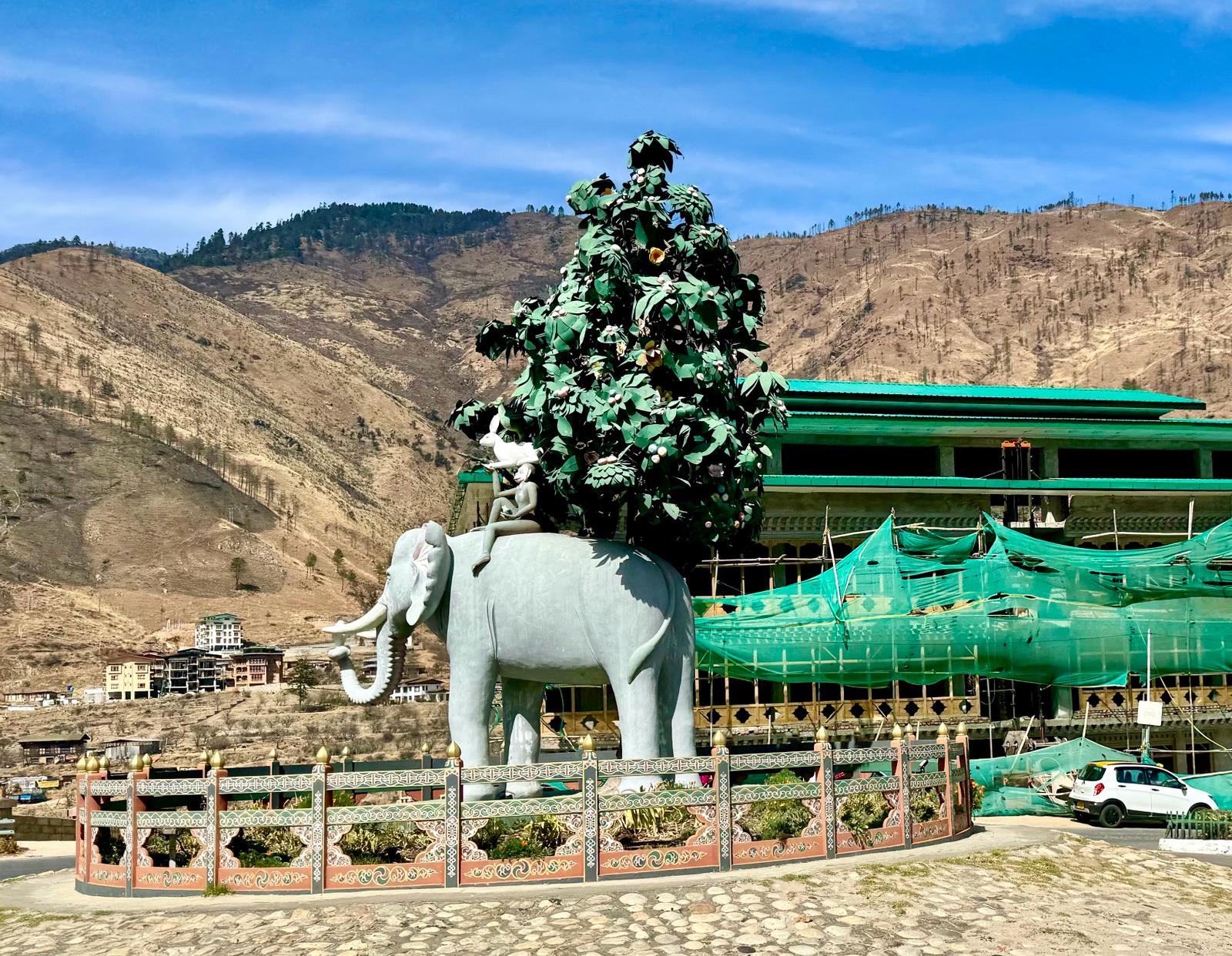
We continued down the valley alongside the Wang Chhu River. Along the way we passed many more prayer flag stations hosting the vertical flags representing the five elements. Large power pylons are quite prevalent along the valley as the largest income earner for Bhutan is electricity, created from the many hydro dams in the country. This is followed next by tourism.
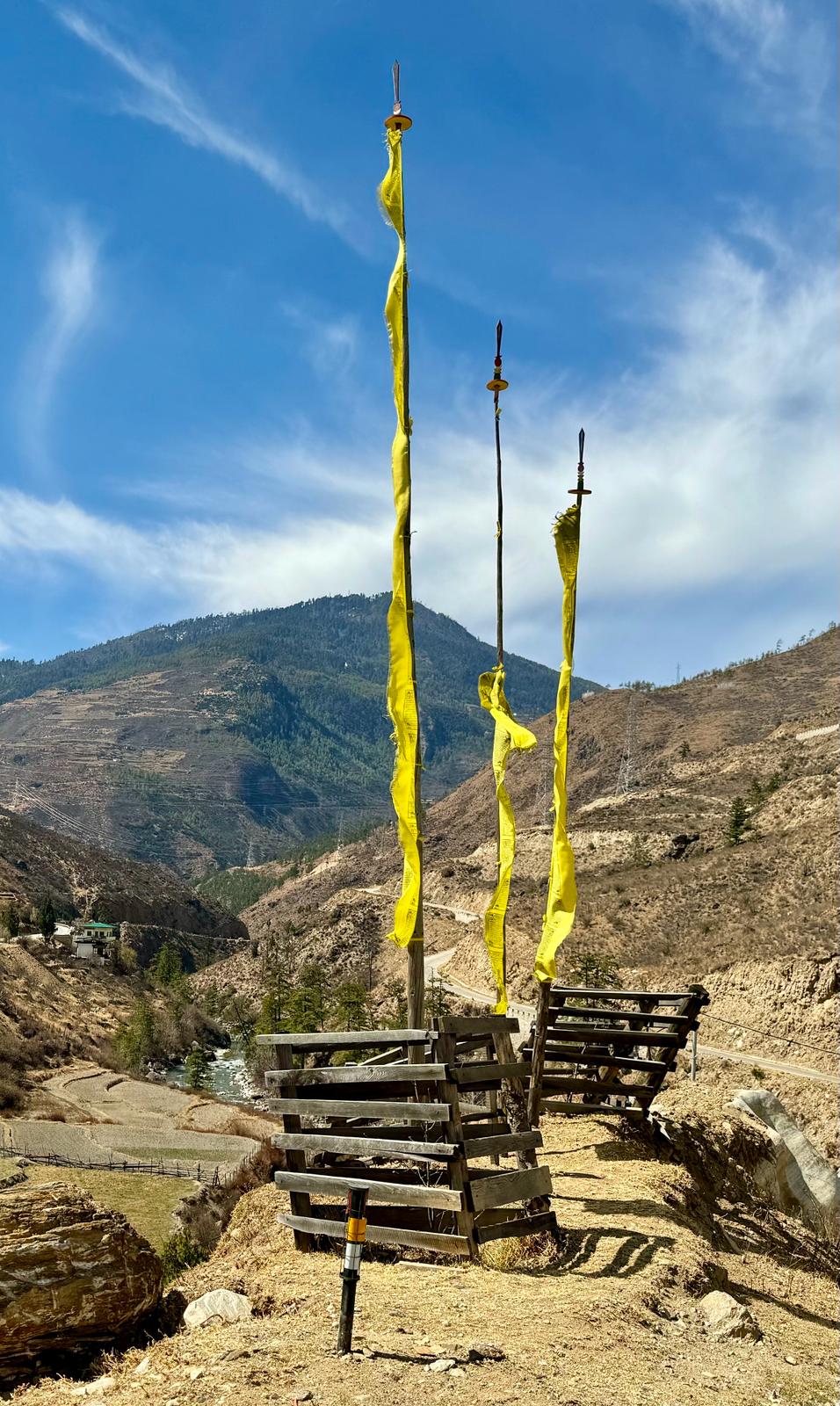




People drive very slowly and respectfully here and there are signs along the highway, encouraging safe driving. One in particular appealed to us: “No hurry No worry”. There are lots of stalls and markets on the side of the road as well as the odd petrol station.
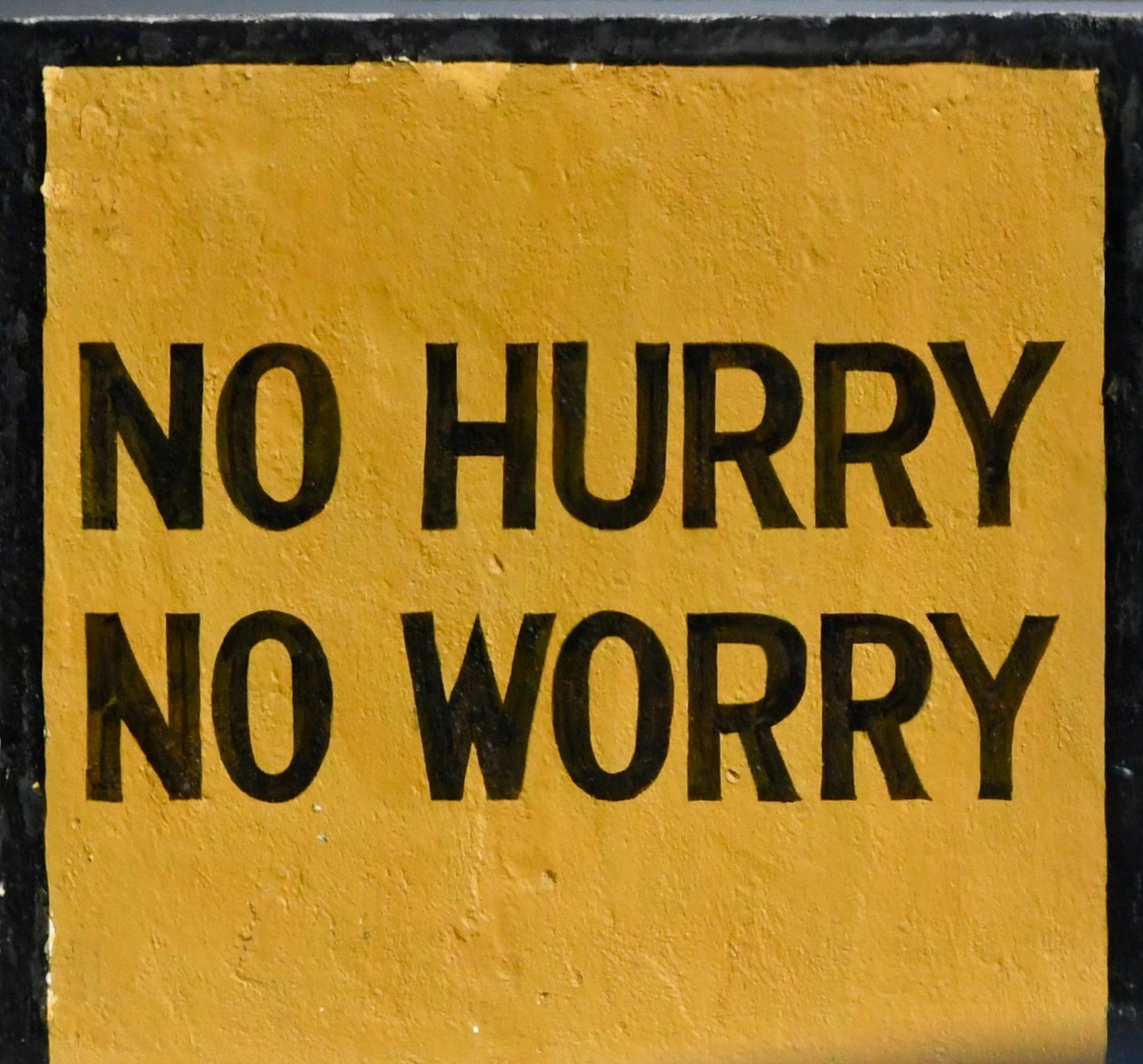
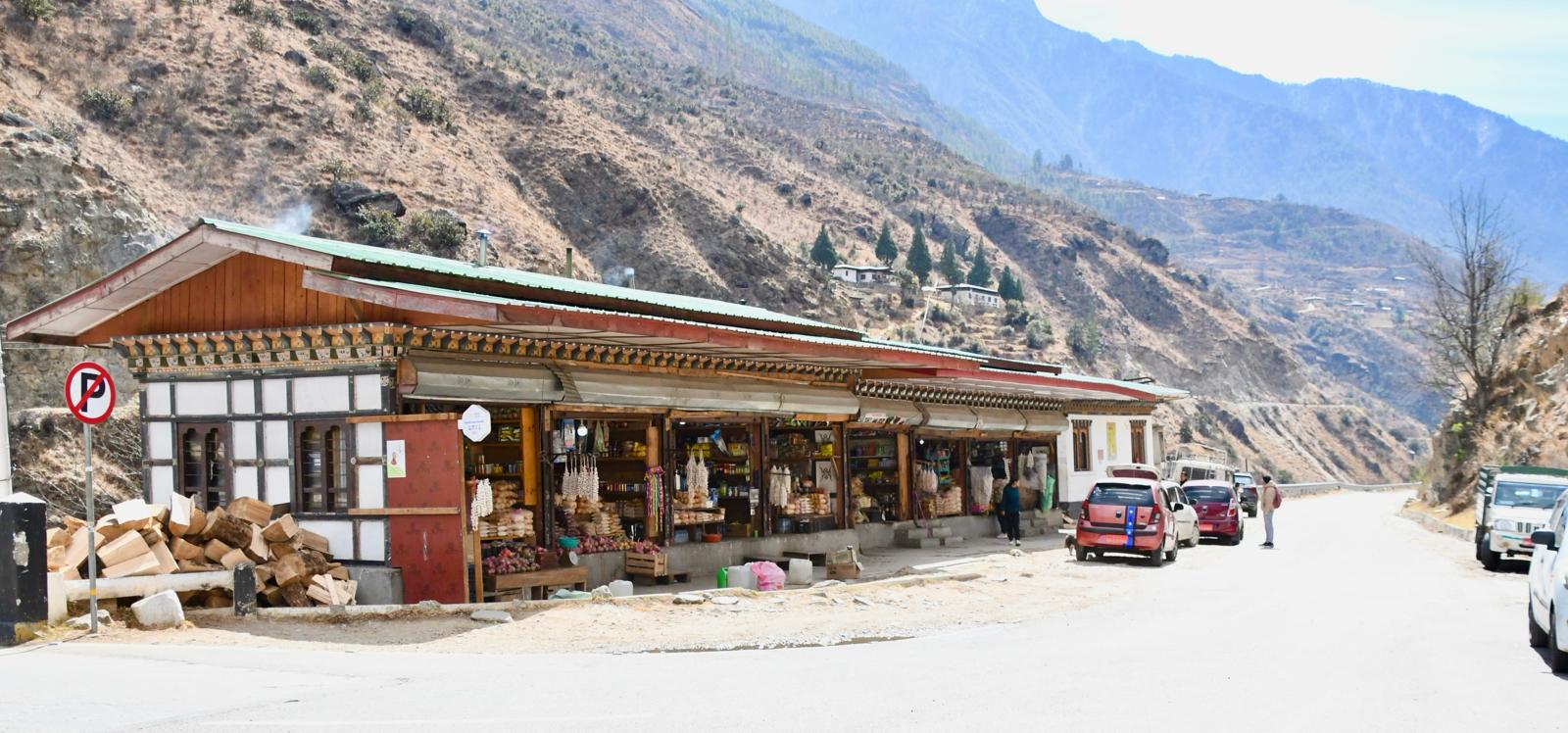
After about 40 minutes, we came to a point where the Paro Chhu River converges with the Wang Chhu River and heads south to India. Three chorten stand on the riverbank at the intersection of the rivers, apparently to ward off the evil spirits where the waters meet. Looking back as we crossed the bridge was a 3m by 12m billboard with a photo of the king and queen on it. The king, now in his early 40’s, under the Bhutanese law, will have to abdicate from the throne at the age of 60, as his father did before him, to allow his oldest child to take over the throne.


As we carried on up the valley, Sylvia had been talking about these little cupcake things stuck in holes in the bank along the roadside. Eventually we came upon a whole bunch of them stacked up higgledy piggledy. These miniature stupa or chorten each contain a relic and bring good will.
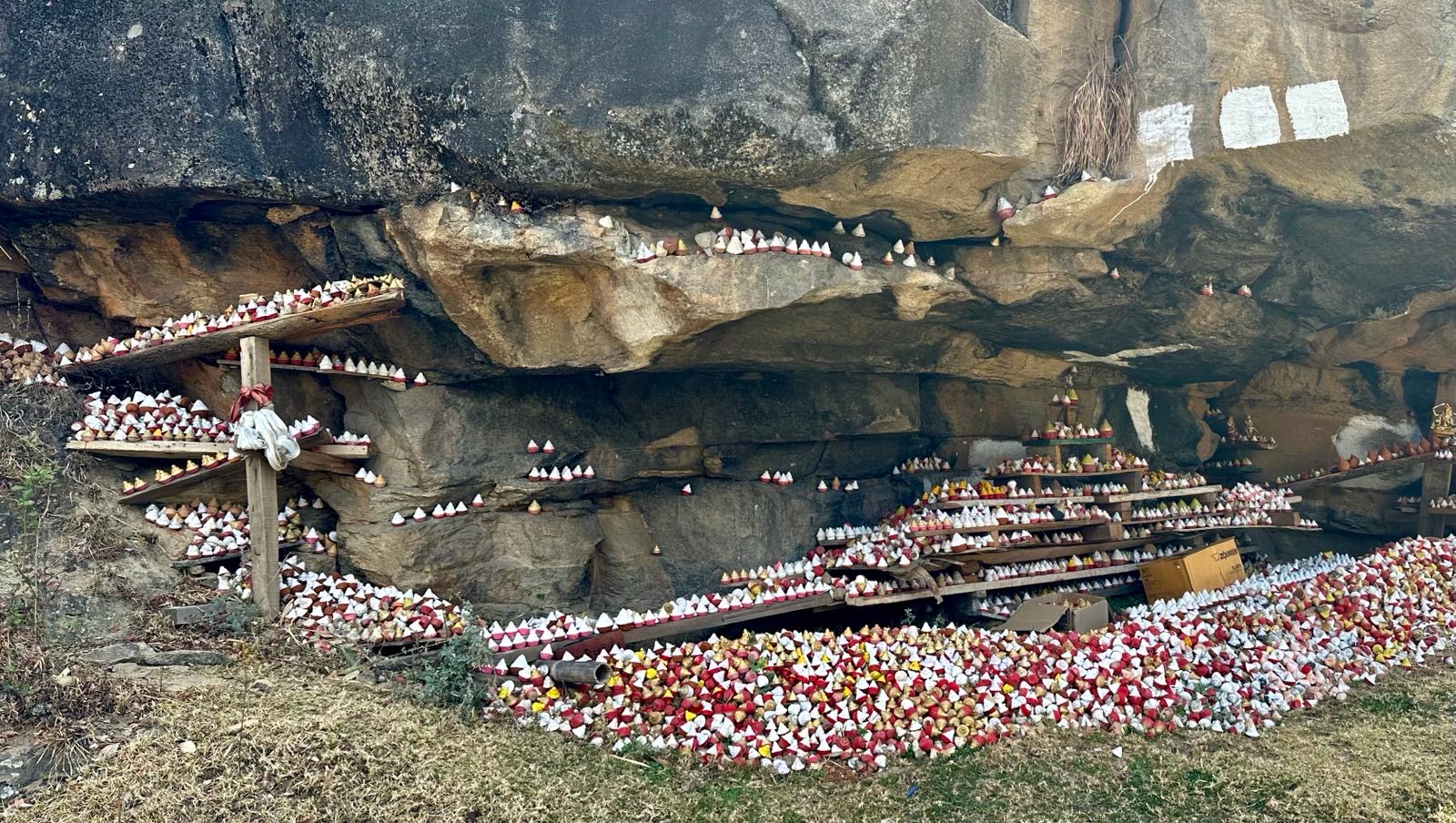

We headed into Paro, passing the airport, and through the town to a small farm, where we were hosted by Mr Sonam Dargay, the owner of the three acres and also a traditional maker of prayer flags. The farm and prayer flag making tradition have been in his family for generations. Part of the traditional three storey house is over 300 years old. Before entering the house there was a vessel of water which we dipped a branch into and used to sprinkle water around to bless our entry to the house. We then climbed some steep stairs to the first, and then up to the second floor, where we passed through the kitchen and were seated in the living room. There we were served a very nice traditional lunch. One of the Six Senses staff was there to interpret as the farmer explained to us how he cultivated his three acres of land, growing rice during the summer and potatoes during the winter. Out the back of the house he also has a large vegetable garden where all the vegetables we ate for lunch had been grown.
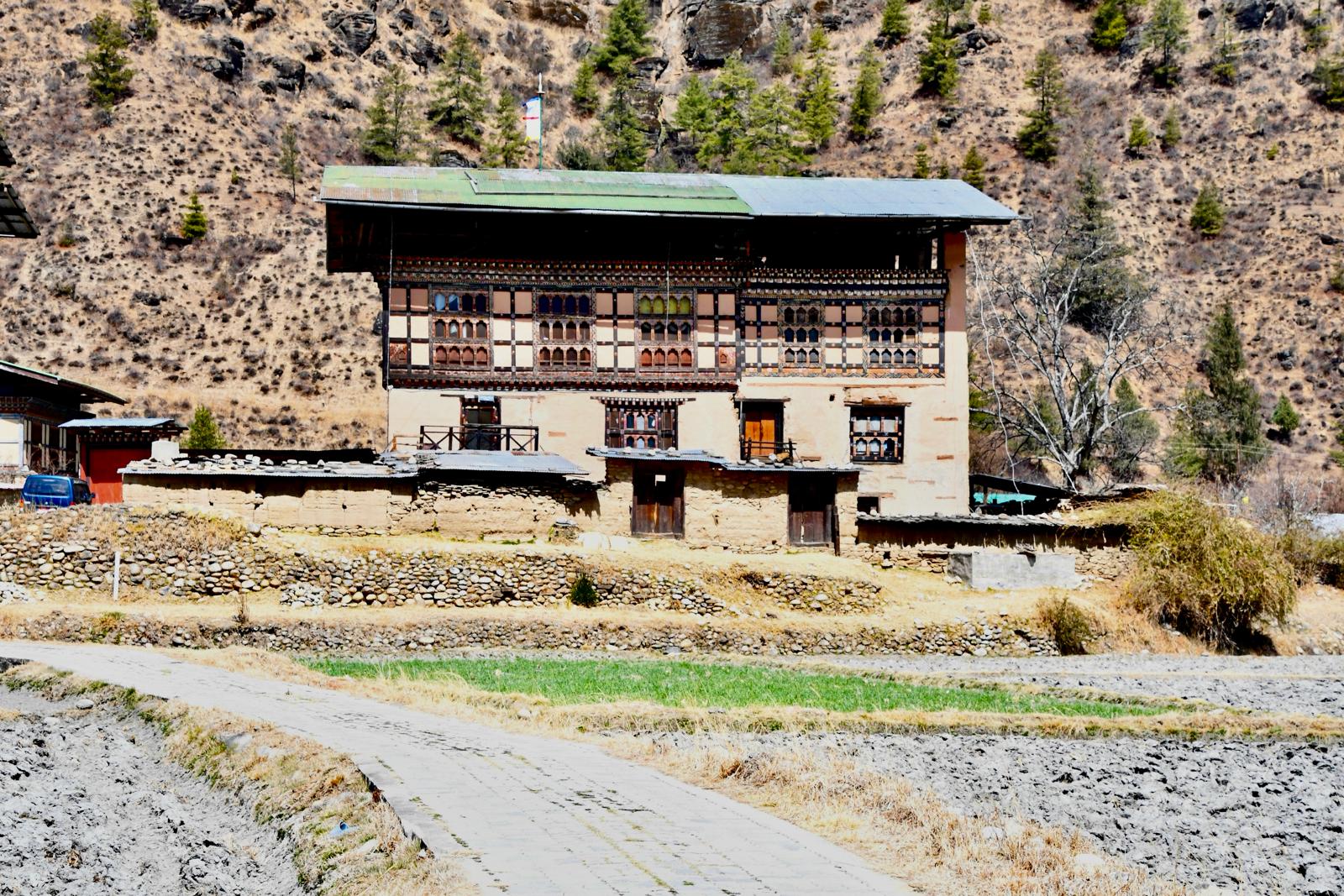



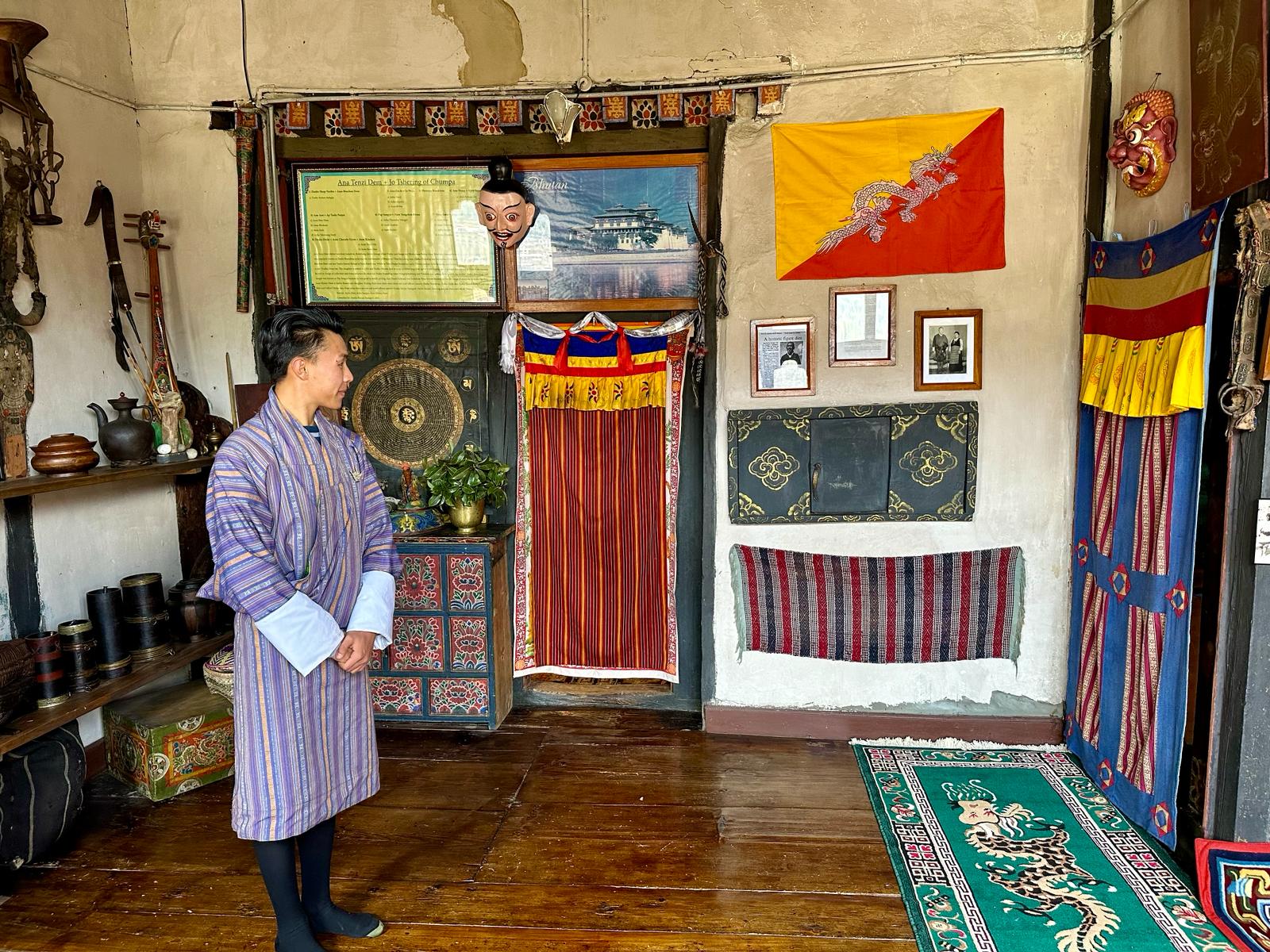

We were then taken to another room, which off to one side has a large altar room, which most houses in Bhutan have, but not all as big as this one. We sat down where Mr Sonam Dargay painted in ink made from black soil onto a die. Each die represents a different mantra and is used to print on a different coloured prayer flag. The flag is draped over the top and we used a leaf to rub back and forth to bring the ink through onto the flag. Sylvia did this for one set of flags and I did another. At the end we were each presented our set of prayer flags.






I had seen cattle in the yard outside the house and asked if the stock were kept under the house. The farmer said yes and agreed to let us have a look. We descended the steep stairs back to the first floor then another steeper set outside to the ground floor. About two thirds of the ground floor is used to house his five cows and one calf, in the other third he stores the rice that will feed the family until the next harvest season. In the back room he pointed out a large box filled with rice and sealed with cow dung, which will stop insects getting into the box so the rice can last for up to three years. As we left Mr Dargay pointed out an old ox yoke and plough leaning up against the wall that is no longer in use as he proudly showed us his new tricycle walk-behind rotary hoe that he now uses to cultivate the land.
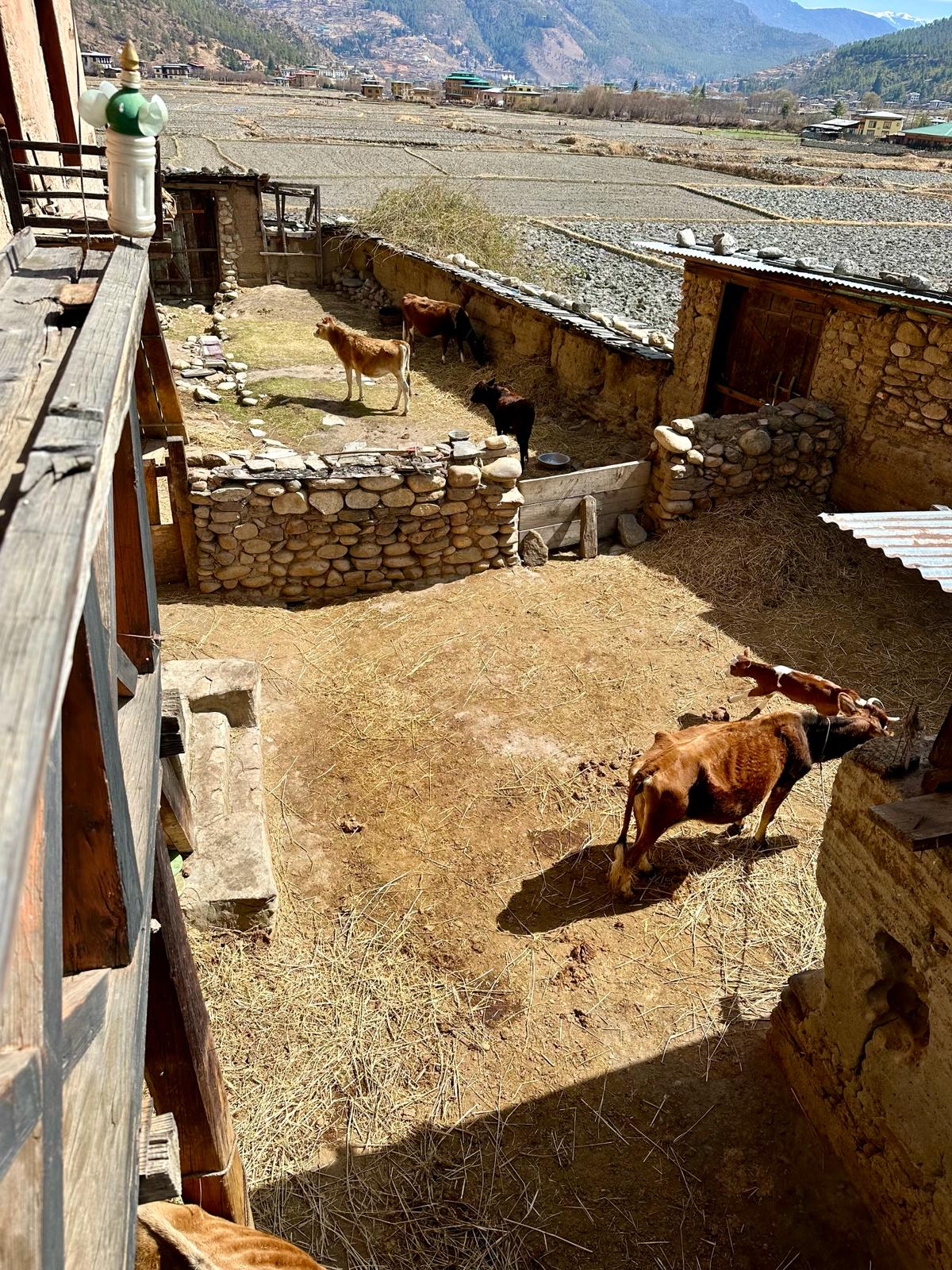




This was such an enjoyable and unique experience, it was hard to leave as Mr Dargay had been a very hospitable and engaging host, eager to share his knowledge of both farming and prayer flag making.
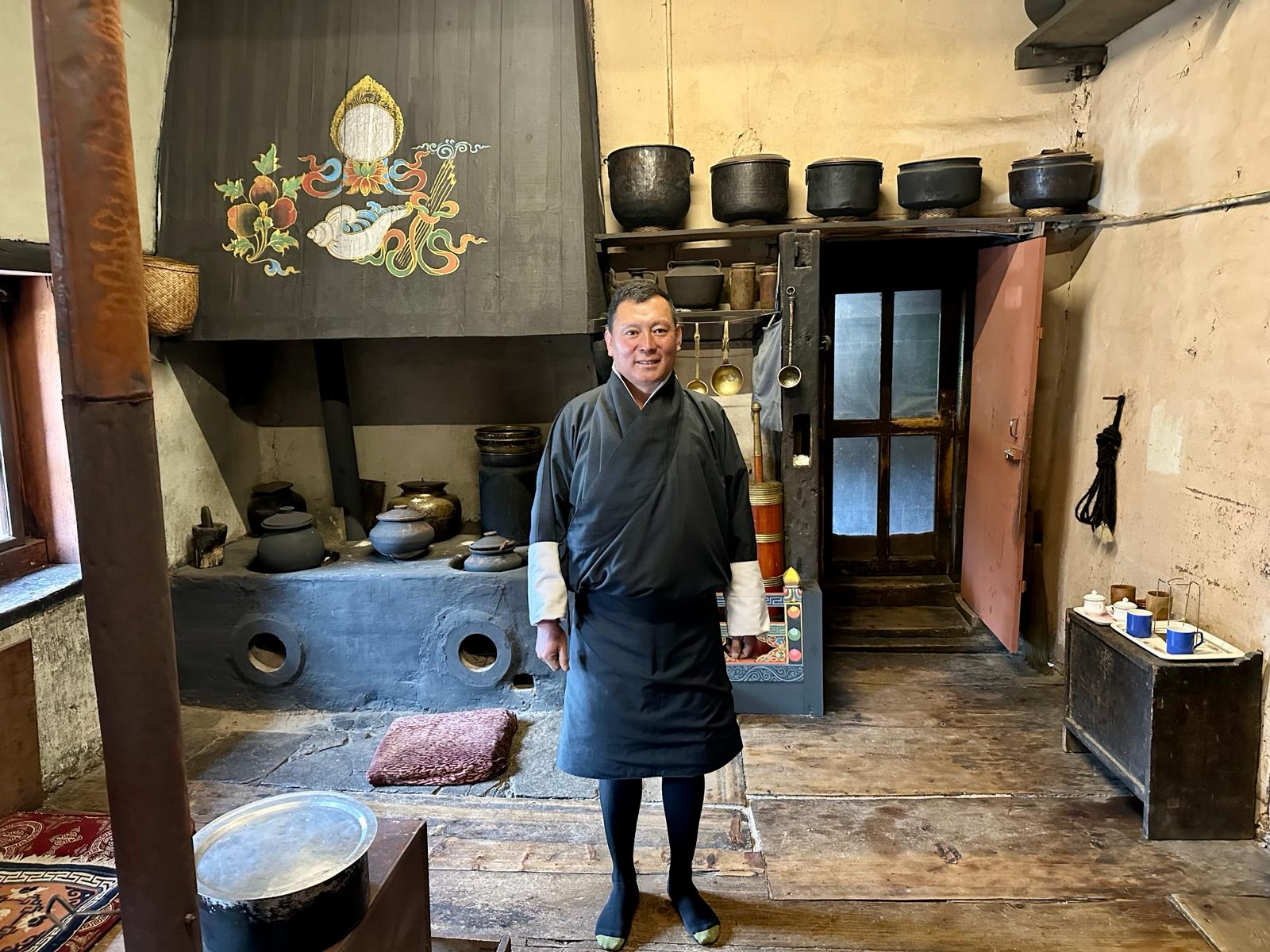
From there we headed to the Kyichu Lhakhang, one of the oldest temples in Bhutan. When Chimi went to buy tickets we were turned away as the king’s grandmother, now in her nineties, was on her way to visit and foreigners were not welcome in the temple during her visit. We headed back towards town stopping on the side of the road as her convey passed us heading in the opposite direction with their lights flashing.
We continued into the centre of town, which is indeed a tourist town, with Paro being the main point of entry to the country. It is completely full of tourist shops filled with a variety of things from a variety of colourful penis shapes, to very expensive teapots and much more. One particular shop we had a look inside had quite a collection of old masks, teapots and other relics that can best be shown in photographs.The buildings here are quite unique, painted in different colours and ornate designs.

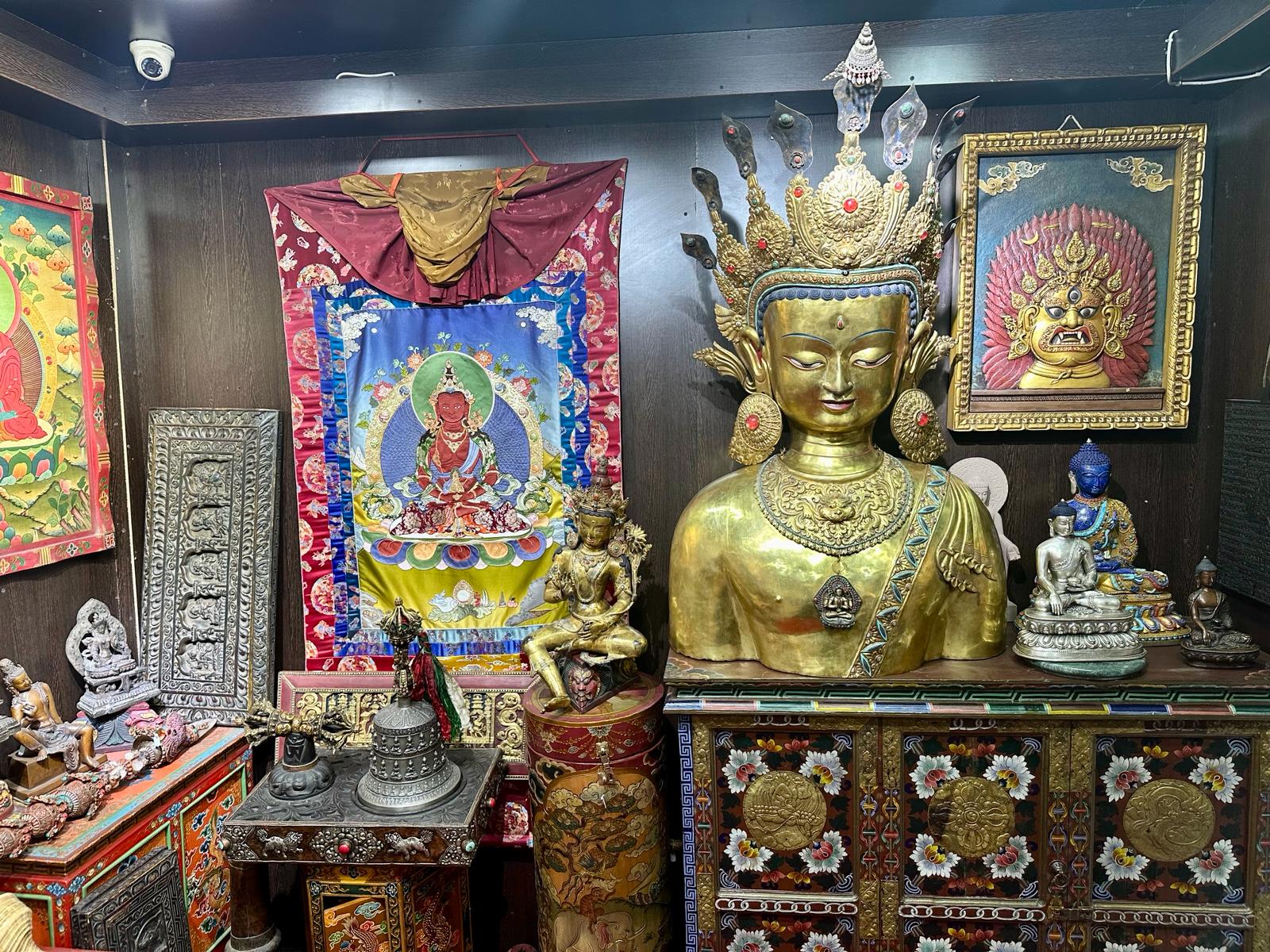




From town we headed up the valley passing many new buildings under construction and lots of rice fields, before heading up a steep dusty road, winding its way through apple orchards, pine forest and passing many houses, often with large stacks of timber sitting alongside them, covered with corrugated iron. We eventually arrived at the Six Senses Paro “Stone Ruins” at an altitude of 2,873m. We were greeted by the very friendly staff and a lady ringing a gong, escorted inside and served a welcoming drink before being escorted across to our villa. From here we have a view of the 15th century stone ruins after which this property is named, and also a view through the pine trees to the valley about 1,000m below us.


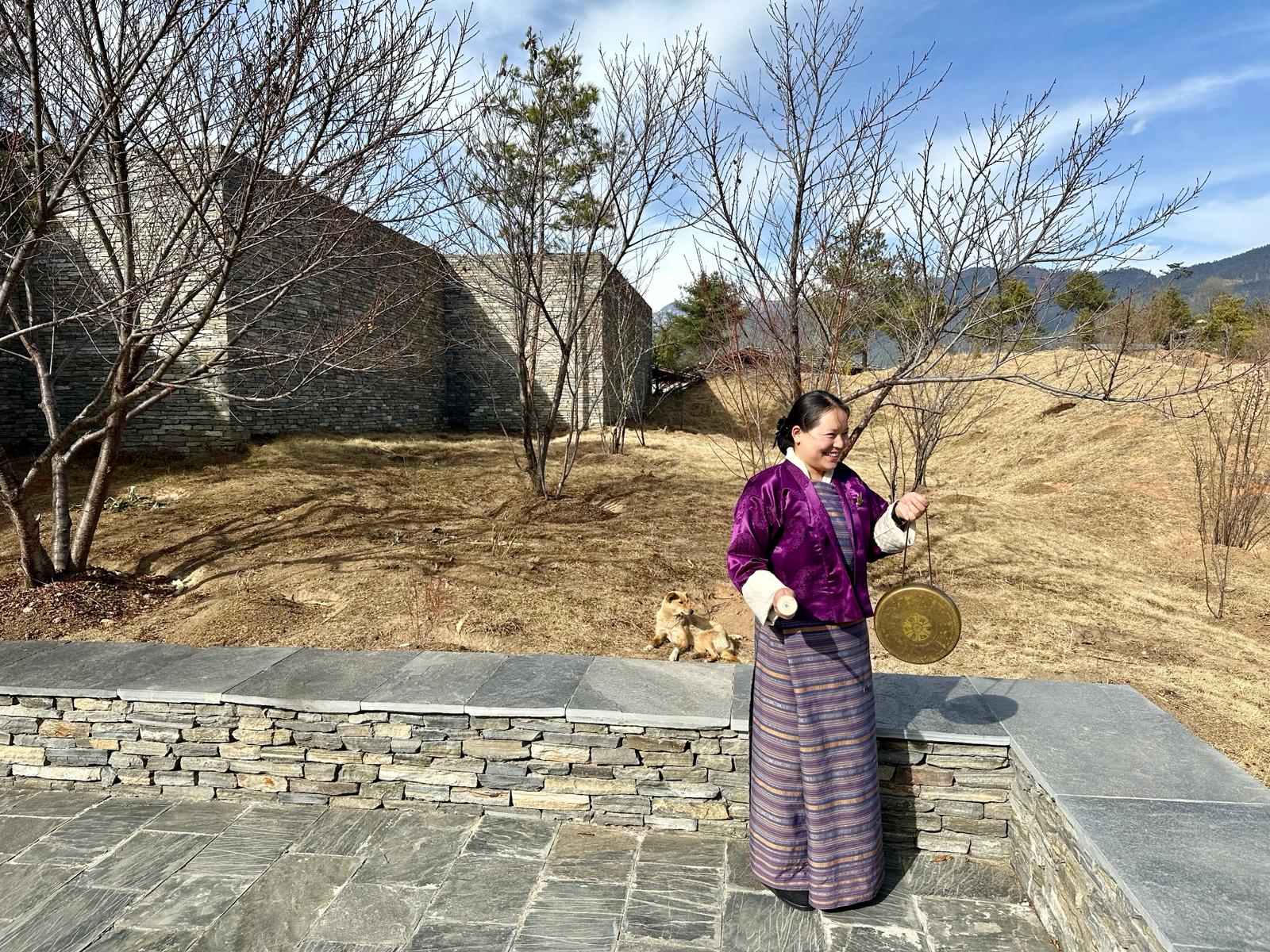

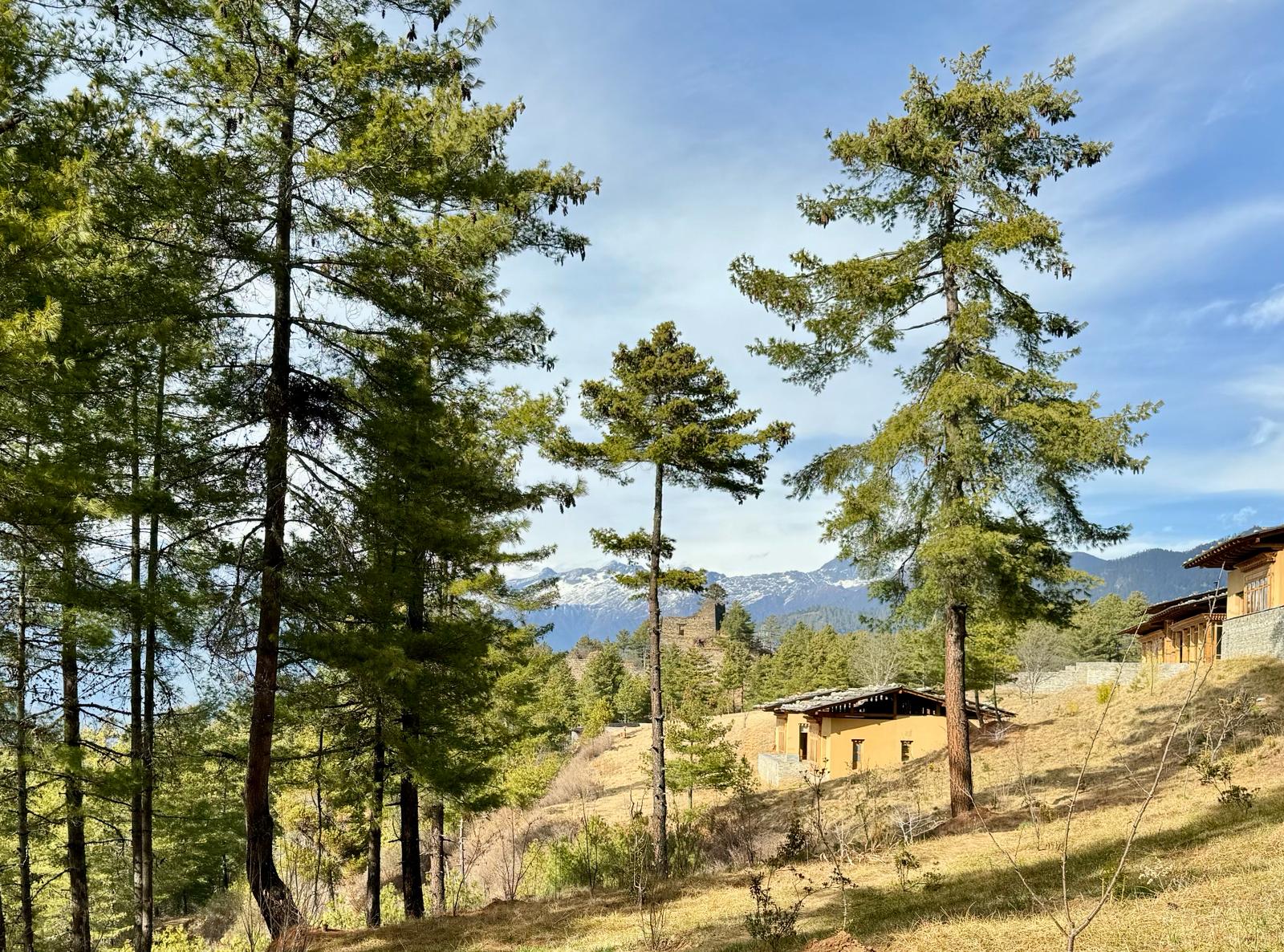

Thank you so much Sir and Madam for visiting Bhutan post and for making your personalize stamps.
Great to see your photos of Thimphu.
We were there September- October 2017 as volunteers. (I was teaching medical students and staff at the hospital over a 5 week period). I suspect there has been a lot more tourist infrastructure put in since then.
The people are wonderful and we really liked the whole approach of the government, favouring ‘gross national happiness’ over GNP.
Look forward to more accounts of your trip.
Philip
magnifique, le seul pays au monde ou le Bonheur national Brut est plus important que le produit économique national Brut…
incroyables images bravo aux photographes…
Fabulous blog and photos. Thank you Sylvie and Roger. You have done yourselves proud and we are so looking forward to seeing the next part of your journey. What a country! Xxx
Amazing!
Fascinating!! Thank you….
Sylvia and Roger. Thank you. Amazing commentary and photos. Kudos to you both for enabling us to share your spectacular journeys.